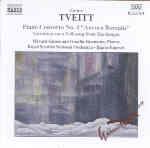How do you describe wonderful music that few if any listeners have ever heard? Norwegian composer Geirr Tveitt might be said to resemble Bartók, in that he evolved an obviously modern musical idiom that’s steeped in the folk music of his native country but never sounds merely imitative. Even his best-known work, the set of One Hundred Tunes from Hardanger, completely avoids the cloying cuteness so typical of stylized, Romanticized folk song settings. On the other hand, Tveitt is interested neither in Bartók’s formal control nor the great Hungarian’s more chilling, expressionistic side.
Indeed, the composer Tveitt most resembles stylistically (without actually sounding anything like him) is Manuel de Falla. Tveitt’s Piano Concerto No. 4 “Aurora Borealis”, actually a tone poem in three movements for piano and orchestra, is a sort of northern take on Nights in the Gardens of Spain. There’s the same mystery, the same luminous instrumental textures, the same gorgeously evocative keyboard writing and close integration of the soloist within the larger ensemble. But the two pieces sound nothing alike: instead of Falla’s supremely polished surfaces and delicate impressionistic colors, Tveitt offers rugged textures and bold rhythms more suited to the Norwegian folk idiom that lies at the heart of his expressive personality. Also like Falla’s piece, the concerto’s three movements are organized in a slow-fast-slow pattern. Tveitt’s program is: (1) The Northern Lights awakening above the autumn colors; (2) Glittering in the winter heavens; and (3) Fading away in the bright night of spring. And that’s just what you hear. Need I say more?
Variations on a Folksong from Hardanger, for two pianos and orchestra, certainly adds a welcome blast of fresh repertoire to a scandalously neglected medium, but one that’s fortunately well served by the likes of Mozart, Piston, Martinu, Poulenc, and a few others. At slightly more than 30 minutes, this single-movement piece is even longer than the concerto, but there’s never a dull moment. The theme itself is lovely and quite memorable, making the variations relatively easy to follow, and Tveitt’s resourceful handling of his solo and orchestral forces guarantees an extremely pleasing listen. Both works date from roughly the same period, 1947-49, and we can only be grateful that they escaped destruction in the fire that consumed the majority of this excellent composer’s music in the early 1970s.
As to the performances, my only quibble is that Naxos neglects to specify which of the two pianists takes the solo part in the concerto, though I assume that it’s Havard Gimse (since he gets top billing), who along with his colleague Gunilla Süssmann plays extremely well throughout. In general, music for two pianos tends to suffer from excessive banging and clanging, but even the most vigorous passages here never degenerate into mere noise, and the balances between keyboards and orchestra in both works are especially well judged by the players and engineers alike. Toss into the pot brilliant orchestral accompaniments under the sympathetic baton of Bjarte Engeset, as well as vibrant recorded sound, and you have the perfect disc to convince yourself that yes, there still is great music out there that has yet to see the light of day. Fabulous! [11/23/2002]
































